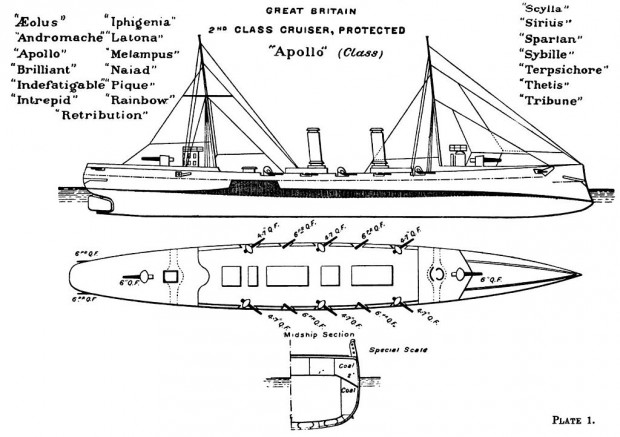Rainbow was one of twenty-one Apollo cruisers built for the British Royal Navy from 1889 to 1894 as part of the building program initiated by the Naval Defense Act of 1889.[1] The Russian war scare of 1884 had revealed that the Royal Navy was stretched thin and, while ships of all classes were needed, sufficient cruisers to protect the shipping over Britain’s vast empire were a particularly compelling requirement. The Naval Defense Act, instituted at a time when technology in metallurgy, ordinance and steam propulsion was becoming sufficiently mature and stable to permit more confidence in ship designs, this program provided for a larger number of ships in each class.
The Apollo’s were originally planned as a class of twenty-nine to meet the demand for a moderate size cruiser in sufficient numbers for the trade protection role. A follow on to the Medea class design, the Apollo’s were considered to be a larger and more heavily armed vessel. In a table taken from Brassey’s Naval Annual (1888-89),the specifications were[2]:
The class was immediately criticized as being too lightly armored for its intended role, despite the addition of the new 4.7-inch quick-firing guns mounted broadside in lieu of the slower breech loading six-inch weapon used in earlier classes of small cruisers. The gunnery layout was considered particularly weak with respect to fore and aft fire where only the 6-inch and one or two of the 6-pounders could be brought to bear. The Apollo program was stopped after twenty-one ships were built, and eight units of the Astraea class were built as an upgrade.
Anyone interested in researching the characteristics of HMCS Rainbow can consult a variety of books for a listing of her technical specifications, and with respect to her armament, get many different answers. While all references agree that Rainbow was equipped with two 6-inch guns mounted on the fo’c’sle and quarterdeck, they vary considerably in the description of her secondary armament. Some mention a battery of 4-inch and 6-pounder guns with small torpedo tubes, while others refer to 4.7-inch guns and/or 12-pounders.[3]

Why then are the accounts of her weapons fit at such a variance? This transgression is covered in Mark Tunnicliffe’s Rainbows Guns – What and When? The answer lies partly in the fact that her armament did change from time to time and most accounts have simply not been sufficiently careful in specifying the time frame to which they are referring when they give the ship’s statistics. The other part of the answer seems to lie in typographical errors[4]. These misprints seem to have led to some rather curious misusing’s on the subject by the RCN’s Naval Historical Section in 1961 who concluded that Rainbows original armament had been reduced, with the replacement of her 4.7-inch and 6-pounder guns.[5]
The bottom line is that only a modest attempt had been made to ensure that Rainbow’s armament had been updated to meet her needs as a training cruiser in 1910. Most of her systems were certainly obsolescent by the time that Canada had acquired the ship and no significant attempt was made to update them while she was in Canadian service. After her decommissioning in 1917, her guns, along with her crew, continued the war in the Atlantic – a distant war that Rainbow was too worn out to join.

